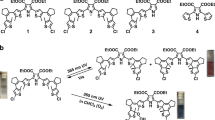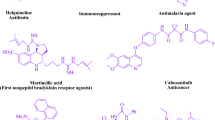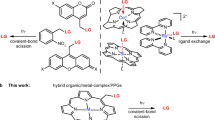Abstract
Photoinduced electron transfer (PET) is a phenomenon whereby the absorption of light by a chemical species provides an energetic driving force for an electron-transfer reaction1,2,3,4. This mechanism is relevant in many areas of chemistry, including the study of natural and artificial photosynthesis, photovoltaics and photosensitive materials. In recent years, research in the area of photoredox catalysis has enabled the use of PET for the catalytic generation of both neutral and charged organic free-radical species. These technologies have enabled previously inaccessible chemical transformations and have been widely used in both academic and industrial settings. Such reactions are often catalysed by visible-light-absorbing organic molecules or transition-metal complexes of ruthenium, iridium, chromium or copper5,6. Although various closed-shell organic molecules have been shown to behave as competent electron-transfer catalysts in photoredox reactions, there are only limited reports of PET reactions involving neutral organic radicals as excited-state donors or acceptors. This is unsurprising because the lifetimes of doublet excited states of neutral organic radicals are typically several orders of magnitude shorter than the singlet lifetimes of known transition-metal photoredox catalysts7,8,9,10,11. Here we document the discovery, characterization and reactivity of a neutral acridine radical with a maximum excited-state oxidation potential of −3.36 volts versus a saturated calomel electrode, which is similarly reducing to elemental lithium, making this radical one of the most potent chemical reductants reported12. Spectroscopic, computational and chemical studies indicate that the formation of a twisted intramolecular charge-transfer species enables the population of higher-energy doublet excited states, leading to the observed potent photoreducing behaviour. We demonstrate that this catalytically generated PET catalyst facilitates several chemical reactions that typically require alkali metal reductants and can be used in other organic transformations that require dissolving metal reductants.
This is a preview of subscription content, access via your institution
Access options
Access Nature and 54 other Nature Portfolio journals
Get Nature+, our best-value online-access subscription
$29.99 / 30 days
cancel any time
Subscribe to this journal
Receive 51 print issues and online access
$199.00 per year
only $3.90 per issue
Buy this article
- Purchase on Springer Link
- Instant access to full article PDF
Prices may be subject to local taxes which are calculated during checkout



Similar content being viewed by others
Data availability
The data supporting the findings of this study are available within the paper and its Supplementary Information.
References
Mattay, J. Photoinduced electron transfer in organic synthesis. Synthesis 1989, 233–252 (1989).
Bauer, A., Westkämper, F., Grimme, S. & Bach, T. Catalytic enantioselective reactions driven by photoinduced electron transfer. Nature 436, 1139–1140 (2005).
Fox, M. A. Photoinduced electron transfer. Photochem. Photobiol. 52, 617–627 (1990).
Fukuzumi, S. New development of photoinduced electron-transfer catalytic systems. Pure Appl. Chem. 79, 981–991 (2007).
Romero, N. A. & Nicewicz, D. A. Organic photoredox catalysis. Chem. Rev. 116, 10075–10166 (2016).
Prier, C. K., Rankic, D. A. & MacMillan, D. W. C. Visible light photoredox catalysis with transition metal complexes: applications in organic synthesis. Chem. Rev. 113, 5322–5363 (2013).
Johnston, L. J. Photochemistry of radicals and biradicals. Chem. Rev. 93, 251–266 (1993).
Arnold, B. R., Scaiano, J. C. & McGimpsey, W. G. Electron-transfer quenching of excited diphenylmethyl radicals. J. Am. Chem. Soc. 114, 9978–9982 (1992).
Scaiano, J. C., Tanner, M. & Weir, D. Exploratory study of the intermolecular reactivity of excited diphenylmethyl radicals. J. Am. Chem. Soc. 107, 4396–4403 (1985).
Samanta, A. et al. Quenching of excited doublet states of organic radicals by stable radicals. J. Phys. Chem. 93, 3651–3656 (1989).
Weir, D. & Scaiano, J. C. Substituent effects on the lifetime and fluorescence of excited diphenylmethyl radicals in solution. Chem. Phys. Lett. 128, 156–159 (1986).
Scordilis-Kelley, C. Alkali metal reduction potentials measured in chloroaluminate ambient-temperature molten salts. J. Electrochem. Soc. 139, 694–699 (1992).
Margrey, K. A. & Nicewicz, D. A. A general approach to catalytic alkene anti-Markovnikov hydrofunctionalization reactions via acridinium photoredox catalysis. Acc. Chem. Res. 49, 1997–2006 (2016).
Romero, N. A. & Nicewicz, D. A. Mechanistic insight into the photoredox catalysis of Anti-Markovnikov alkene hydrofunctionalization reactions. J. Am. Chem. Soc. 136, 17024–17035 (2014).
Ghosh, I., Ghosh, T., Bardagi, J. I. & König, B. Reduction of aryl halides by consecutive visible light-induced electron transfer processes. Science 346, 725–728 (2014).
Connell, T. U. et al. The tandem photoredox catalysis mechanism of [Ir(ppy)2(dtb-bpy)]+ enabling access to energy demanding organic substrates. J. Am. Chem. Soc. 141, 17646–17658 (2019).
Lu, C., Fujitsuka, M., Sugimoto, A. & Majima, T. Dual character of excited radical anions in aromatic diimide bis(radical anion)s: donor or acceptor? J. Phys. Chem. C 121, 4558–4563 (2017).
Christensen, J. A. et al. Phenothiazine radical cation excited states as super-oxidants for energy-demanding reactions. J. Am. Chem. Soc. 140, 5290–5299 (2018).
Gumy, J.-C. & Vauthey, E. Investigation of the excited-state dynamics of radical ions in the condensed phase using the picosecond transient grating technique. J. Phys. Chem. A 101, 8575–8580 (1997).
Romero, N. A., Margrey, K. A., Tay, N. E. & Nicewicz, D. A. Site-selective arene C-H amination via photoredox catalysis. Science 349, 1326–1330 (2015).
Brancato, G. et al. Dual fluorescence through Kasha’s rule breaking: an unconventional photomechanism for intracellular probe design. J. Phys. Chem. B 119, 6144–6154 (2015).
Demchenko, A. P., Tomin, V. I. & Chou, P.-T. Breaking the Kasha rule for more efficient photochemistry. Chem. Rev. 117, 13353–13381 (2017).
Peng, Z. et al. Expression of anti-Kasha’s emission from amino benzothiadiazole and its utilization for fluorescent chemosensors and organic light emitting materials. J. Mater. Chem. C 6, 7864–7873 (2018).
Scuppa, S., Orian, L., Donoli, A., Santi, S. & Meneghetti, M. Anti-Kasha’s rule fluorescence emission in (2-ferrocenyl)indene generated by a twisted intramolecular charge-transfer (TICT) process. J. Phys. Chem. A 115, 8344–8349 (2011).
Shida, T. Electronic Absorption Spectra of Radical Ions (Elsevier, 1988).
Bhandari, S. & Dunietz, B. D. Quantitative accuracy in calculating charge transfer state energies in solvated molecular complexes using a screened range separated hybrid functional within a polarized continuum model. J. Chem. Theory Comput. 15, 4305–4311 (2019).
Song, Y. et al. Vibronic structure of photosynthetic pigments probed by polarized two-dimensional electronic spectroscopy and ab initio calculations. Chem. Sci. 10, 8143–8153 (2019).
Bhandari, S., Cheung, M. S., Geva, E., Kronik, L. & Dunietz, B. D. Fundamental gaps of condensed-phase organic semiconductors from single-molecule calculations using polarization-consistent optimally tuned screened range-separated hybrid functionals. J. Chem. Theory Comput. 14, 6287–6294 (2018).
Maiti, B. et al. Enhancing charge mobilities in organic semiconductors by selective fluorination: a design approach based on a quantum mechanical perspective. Chem. Sci. 8, 6947–6953 (2017).
Kerzig, C. & Goez, M. Generating hydrated electrons through photoredox catalysis with 9-anthrolate. Phys. Chem. Chem. Phys. 17, 13829–13836 (2015).
Kerzig, C., Guo, X. & Wenger, O. S. Unexpected hydrated electron source for preparative visible-light driven photoredox catalysis. J. Am. Chem. Soc. 141, 2122–2127 (2019).
Poelma, S. O. et al. Chemoselective radical dehalogenation and C–C bond formation on aryl halide substrates using organic photoredox catalysts. J. Org. Chem. 81, 7155–7160 (2016).
Discekici, E. H. et al. A highly reducing metal-free photoredox catalyst: design and application in radical dehalogenations. Chem. Commun. 51, 11705–11708 (2015).
Narayanam, J. M. R., Tucker, J. W. & Stephenson, C. R. J. Electron-transfer photoredox catalysis: development of a tin-free reductive dehalogenation reaction. J. Am. Chem. Soc. 131, 8756–8757 (2009).
Yin, H. et al. The hexachlorocerate(III) anion: a potent, benchtop stable, and readily available ultraviolet A photosensitizer for aryl chlorides. J. Am. Chem. Soc. 138, 16266–16273 (2016).
Javorskis, T. & Orentas, E. Chemoselective deprotection of sulfonamides under acidic conditions: scope, sulfonyl group migration, and synthetic applications. J. Org. Chem. 82, 13423–13439 (2017).
Shohji, N., Kawaji, T. & Okamoto, S. Ti(O-i-Pr)4/Me3SiCl/Mg-mediated reductive cleavage of sulfonamides and sulfonates to amines and alcohols. Org. Lett. 13, 2626–2629 (2011).
Alonso, E., Ramón, D. J. & Yus, M. Reductive deprotection of allyl, benzyl and sulfonyl substituted alcohols, amines and amides using a naphthalene-catalysed lithiation. Tetrahedron 53, 14355–14368 (1997).
Acknowledgements
This work was supported in part by the National Institutes of Health (NIGMS) Award number R01 GM120186 (D.A.N.). L.W. was supported by the National Natural Science Foundation of China (21801011) and the International Postdoctoral Exchange Fellowship Program (20180033). O.F.W. and A.M. were supported by the National Science Foundation under grant CHE-1763207. Photophysical measurements were performed in the AMPED EFRC Instrumentation Facility established by the Alliance for Molecular PhotoElectrode Design for Solar Fuels (AMPED), an Energy Frontier Research Center (EFRC) funded by the US Department of Energy, Office of Science, Office of Basic Energy Sciences under Award DE-SC0001011. B.D.D. acknowledges support for this project by the Department of Energy, Office of Basic Energy Sciences through the Chemical Sciences Geosciences and Biosciences Division, under grant number DE- SC0016501.
Author information
Authors and Affiliations
Contributions
I.A.M. and D.A.N. were responsible for the initial conception of the project. I.A.M., L.W. and N.P.R.O. devised and executed all experimental work. N.P.R.O., D.A.N., K.B., B.D.D., O.F.W. and I.A.M. assisted in the preparation and editing of the final manuscript. O.F.W. assisted in the collection and O.F.W. and A.M.M. performed analysis of transient absorption data. B.D.D. designed the computational approach, K.B. executed the calculations and K.B., B.D.D., N.P.R.O. and D.A.N. were responsible for the analysis of computations.
Corresponding author
Ethics declarations
Competing interests
The authors declare no competing interests.
Additional information
Publisher’s note Springer Nature remains neutral with regard to jurisdictional claims in published maps and institutional affiliations.
Supplementary information
Supplementary Information
This file contains Supplementary 1-16 which includes tables and figures.
Rights and permissions
About this article
Cite this article
MacKenzie, I.A., Wang, L., Onuska, N.P.R. et al. Discovery and characterization of an acridine radical photoreductant. Nature 580, 76–80 (2020). https://doi.org/10.1038/s41586-020-2131-1
Received:
Accepted:
Published:
Issue Date:
DOI: https://doi.org/10.1038/s41586-020-2131-1
This article is cited by
-
Electrophotocatalytic hydrogenation of imines and reductive functionalization of aryl halides
Nature Communications (2024)
-
Red light-driven electron sacrificial agents-free photoreduction of inert aryl halides via triplet-triplet annihilation
Nature Communications (2023)
-
Photoredox-active Cr(0) luminophores featuring photophysical properties competitive with Ru(II) and Os(II) complexes
Nature Chemistry (2023)
-
Formation and degradation of strongly reducing cyanoarene-based radical anions towards efficient radical anion-mediated photoredox catalysis
Nature Communications (2023)
-
Perspective on acridine: a versatile heterocyclic biologically imperative framework
Journal of the Iranian Chemical Society (2023)
Comments
By submitting a comment you agree to abide by our Terms and Community Guidelines. If you find something abusive or that does not comply with our terms or guidelines please flag it as inappropriate.



